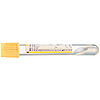PLI
| ||||||||||||||||||||||||||||||


Indicaties
Staalname
- Geen interferentie door hemolyse, icterie of lipemie. Een uitgevast staal is steeds te verkiezen, al was het maar in het belang van andere te bepalen testen, voor deze test is het geen must mocht vasten tegenaangewezen zijn zoals bij diabetes mellitus of erge zwakte.
- Lange-termijn corticosteroïden (hond), chronische nierinsufficiëntie (hond en kat), dunne-naaldaspiratie (hond) en chirurgische bioptie (hond en kat) van de pancreas veroorzaken geen verhoging van PLI. [4][5][6][7][8]
Stabiliteit
minstens 21d ongeacht de bewaartemperatuur[9]
- meerdere dagen bij 20-25 °C[10]
- meerdere weken bij 4 °C
- meerdere jaren bij (-20)-(-80) °C
Interpretatie
De meest gevoelige en specifieke test voor de diagnose van pancreatitis is evenwel PLI.[11][12]
- Een normaal of negatief resultaat sluit actieve pancreatitis uit.
- Licht verhoogd of zwak positief resultaat: komt overeen met een concentratie van 200-400 µg/L bij de hond en 3.6-5.3 µg/L bij de kat. Pancreatitis is mogelijk maar niet zeker. Hertesten na 2w is aanbevolen.
- Sterk verhoogd of positief: komt overeen met een concentratie van >200 µg/L bij de hond en >5.3 µg/L bij de kat. Hiermee is actieve pancreatitis aangetoond.
De gevoeligheid van de test voor chronische pancreatitis is wellicht lager dan bij acute.[13] Er moet een significante lekkage van enzymes plaatsvinden, milde gevallen die mogelijk geen klinische betekenis hebben zullen onopgemerkt blijven evenals fibrotische of atrofische letsels.[14]
Alvast bij gezonde honden een hoge inter- maar ook intra-individuele biologische variabiliteit bestaat waardoor het weinig nut heeft om de parameter te gebruiken als monitoring (de waarde moet minstens 4,5x dalen om met grote zekerheid toe te schrijven aan genezing).[15] Een duidelijke klinische verbetering gaat niet steeds gepaard met een snelle daling van het serum PLI.[5] Om het onstekingsproces op te volgen raden wij daarom bij de hond CRP en bij de kat SAA aan.
Zowel de semikwantitatieve als de kwantitatieve bepaling kunnen niet gebruikt worden voor de diagnose van EPI. De assay werd immers geoptimaliseerd voor de detectie van hoge concentraties niet voor lage.[13] Gebruik hiervoor TLI.
Referenties
- ↑ Israeli et al.: Serum pepsinogen-A, canine pancreatic lipase immunoreactivity, and C-reactive protein as prognostic markers in dogs with gastric dilatation-volvulus. J. Vet. Intern. Med. 2012;26:920-8. PMID: 22594637. DOI.
- ↑ Kathrani et al.: Elevated canine pancreatic lipase immunoreactivity concentration in dogs with inflammatory bowel disease is associated with a negative outcome. J Small Anim Pract 2009;50:126-32. PMID: 19261082. DOI.
- ↑ Bailey et al.: Comparisons between cats with normal and increased fPLI concentrations in cats diagnosed with inflammatory bowel disease. J Small Anim Pract 2010;51:484-9. PMID: 21050218. DOI.
- ↑ Steiner JM, Finco DR, Gumminger SR, Williams DA. Serum canine pancreatic lipase immunoreactivity (cPLI) in dogs with experimentally induced chronic renal failure [abstract]. J Vet Intern Med. 2001;15:311.
- ↑ Steiner et al.: Stability of canine pancreatic lipase immunoreactivity concentration in serum samples and effects of long-term administration of prednisone to dogs on serum canine pancreatic lipase immunoreactivity concentrations. Am. J. Vet. Res. 2009;70:1001-5. PMID: 19645581. DOI.
- ↑ Cordner et al.: Effect of pancreatic tissue sampling on serum pancreatic enzyme levels in clinically healthy dogs. J. Vet. Diagn. Invest. 2010;22:702-7. PMID: 20807924.
- ↑ Xenoulis PG, Finco DR, Suchodolski JS, Steiner JM. Serum fPLI and Spec fPL concentrations in cats with experimentally induced chronic renal failure [abstract]. J Vet Intern Med. 2009;23:758.
- ↑ Cosford et al.: Prospective evaluation of laparoscopic pancreatic biopsies in 11 healthy cats. J. Vet. Intern. Med. 2010;24:104-13. PMID: 19925571. DOI.
- ↑ Steiner et al.: Stability of canine pancreatic lipase immunoreactivity concentration in serum samples and effects of long-term administration of prednisone to dogs on serum canine pancreatic lipase immunoreactivity concentrations. Am. J. Vet. Res. 2009;70:1001-5. PMID: 19645581. DOI.
- ↑ Xenoulis & Steiner: Canine and feline pancreatic lipase immunoreactivity. Vet Clin Pathol 2012;41:312-24. PMID: 22861648. DOI.
- ↑ Steiner et al.: Sensitivity of serum markers for pancreatitis in dogs with macroscopic evidence of pancreatitis. Vet. Ther. 2008;9:263-73. PMID: 19177331.
- ↑ Trivedi et al.: Sensitivity and specificity of canine pancreas-specific lipase (cPL) and other markers for pancreatitis in 70 dogs with and without histopathologic evidence of pancreatitis. J. Vet. Intern. Med. 2011;25:1241-7. PMID: 22092611. DOI.
- ↑ 13,0 13,1 Xenoulis & Steiner: Canine and feline pancreatic lipase immunoreactivity. Vet Clin Pathol 2012;41:312-24. PMID: 22861648. DOI.
- ↑ Neilson-Carley et al.: Specificity of a canine pancreas-specific lipase assay for diagnosing pancreatitis in dogs without clinical or histologic evidence of the disease. Am. J. Vet. Res. 2011;72:302-7. PMID: 21355731. DOI.
- ↑ Carney et al.: Biological variability of C-reactive protein and specific canine pancreatic lipase immunoreactivity in apparently healthy dogs. J. Vet. Intern. Med. 2011;25:825-30. PMID: 21564294. DOI.
Links
- Artikels op Pubmed over honden in de laatste 3 jaar
- Artikels op Pubmed over katten in de laatste 3 jaar
